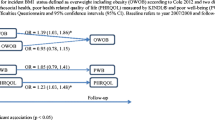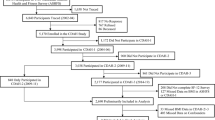Abstract
Purpose
To examine associations between adiposity and adult psychosocial outcomes (depressive symptoms, life satisfaction, self-esteem, household income, personal income, savings/investments) in a New Zealand birth cohort, by gender. Adiposity was assessed using Body Mass Index scores classified on a 3-point scale of BMI: <25.0, overweight (25.0–29.9) or obese (≥30).
Methods
Data were gathered via face-to-face and telephone interviews for the Christchurch Health and Development Study (CHDS), comprising a birth cohort of 1265 children born in Christchurch, New Zealand, in 1977. BMI and psychosocial outcome information was collected in 2007 (30 years; n = 977) and in 2012 (35 years; n = 923).
Results
Population-averaged regression modeling showed evidence of statistically significant (p < 0.05) associations between increasing adiposity and adverse psychosocial outcomes for females, but not for males. After adjustment for child and family background covariates the strength of the associations for females was reduced; with four associations (depressive symptoms, life satisfaction, equivalized household income and savings/investments) remaining statistically significant (p < 0.05). In contrast, for males there was a significant (p = 0.008) positive association between adiposity and higher personal net weekly income after covariate adjustment.
Conclusions
The findings suggest evidence of gender differences in the associations between adiposity and psychosocial outcomes. For females, there were small but pervasive tendencies for increasing adiposity to be related to more adverse mental health, psychological well-being and economic outcomes; whereas for males adiposity was either unrelated to these outcomes, or in the case of personal income, associated with greater economic advantage. The implications of these findings are discussed.
Similar content being viewed by others
References
Organisation for Economic Co-operation and Development (OECD) (2014) Obesity update. Accessed 5 November 2014 http://www.oecd.org/els/health-systems/Obesity-Update-2014.pdf
Bleich S, Cutler D, Murray C, Adams A (2007) Why is the developed world obese? National Bureau of Economic Research, Cambridge
Puhl RM, Hauer CA, Brownell KD (2010) Stigma and social consequences of obesity. Clinicial obesity in adults and children, 3rd edn. John Wiley & Sons Ltd., Chichester
Onyike CU, Crum RM, Lee HB, Lyketsos CG, Eaton WW (2003) Is obesity associated with major depression? Results from the Third National Health and Nutrition Examination Survey. Am J Epidemiol 158(12):1139–1147. doi:10.1093/aje/kwg275
Faith MS, Butryn M, Wadden TA, Fabricatore A, Nguyen AM, Heymsfield SB (2011) Evidence for prospective associations among depression and obesity in population-based studies. Obes Rev 12(5):e438–e453. doi:10.1111/j.1467-789X.2010.00843.x
Simon GE, Von Korff M, Saunders K, Miglioretti DL, Crane PK, van Belle G, Kessler RC (2006) Association between obesity and psychiatric disorders in the US adult population. Arch Gen Psychiatry 63:824–830
Zhao G, Ford ES, Dhingra S, Li C, Strine TW, Mokdad AH (2009) Depression and anxiety among US adults: associations with body mass index. Int J Obes 33:257–266. doi:10.1038/ijo.2008.268
Luppino FS, de Wit LM, Bouvy PF, Stijnen T, Cuijpers P, Penninx BWJH, Zitman FG (2010) Overweight, Obesity, and Depression: a systematic review and meta-analysis of longitudinal studies. Arch Gen Psychiatry 67(3):220–229. doi:10.1001/archgenpsychiatry.2010.2
Atlantis E, Baker M (2008) Obesity effects on depression: systematic review of epidemiological studies. Int J Obes Relat Metab Disord 32:881–891. doi:10.1038/ijo.2008.54
Herva A, Laitinen J, Miettunen J, Veijola J, Karvonen JT, Läksy K, Joukamaa M (2006) Obesity and depression: results from the longitudinal Northern Finland 1966 Birth Cohort Study. Int J Obes 30:520–527
Ball K, Crawford D, Kenardy J (2004) Longitudinal relationships among overweight, life satisfaction, and aspirations in young women. Obes Res 12(6):1019–1030
Mocan NH, Tekin E (2009) Obesity, self-esteem and wages. National Bureau of Economic Research (NBER) working paper series. National Bureau of Economic Research, Cambridge. doi:10.3386/w15101
Gortmaker SL, Aviva M, Perrin JM, Sobol AM, Dietz WH (1993) Social and economic consequences of overweight in adolescence and young adulthood. N Engl J Med 329:1008–1012. doi:10.1056/NEJM199309303291406
McLaren L (2007) Socioeconomic status and obesity. Epidemiol Rev 29:29–48. doi:10.1093/epirev/mxm001
Clarke PJ, O’Malley PM, Schulenberg JE, Johnston LD (2010) Midlife health and socioeconomic consequences of persistent overweight across early adulthood: findings from a national survey of American adults (1986–2008). Am J Epidemiol 172(5):540–548. doi:10.1093/aje/kwq156
Heitmann BL (2010) Obesity and gender. In: Kopelman PG, Caterson ID, Dietz WH (eds) Clinical obesity in adults and children, 3rd edn. Wiley-Blackwell, Chichester, pp 58–64
Miller CT, Downey KT (1999) A meta-analysis of heavyweight and self-esteem. Pers Soc Psychol Rev 3(1):68–84
World Health Organization (1997) Obesity: Preventing and managing the global epidemic. World Health Organization, Geneva
Fergusson DM, Horwood LJ (2013) The Christchurch Health and Development Study. In: Joyce P, Nicholls G, Thomas K, Wilkinson T (eds) The Christchurch experience: 40 years of research and teaching. University of Otago, Christchurch, pp 79–87
Fergusson DM, Horwood LJ (2001) The Christchurch Health and Development Study: review of findings on child and adolescent mental health. Aust N Z J Psychiatry 35(3):287–296
World Health Organization (1993) Composite international diagnostic interview (CIDI). World Health Organization, Geneva, Switzerland
American Psychiatric Association (1994) Diagnostic and statistical manual of mental disorders, 4th edn. American Psychiatric Association, Washington
Rosenberg M (1965) Society and the Adolescent Self-image. Princeton University Press, Princeton
Organisation for Economic Co-operation and Development (OECD) (2007) Purchasing Power Parities (PPPs) for OECD Countries since 1980. Accessed 4 June 2008 http://www.oecd.org/std/ppp
Organisation for Economic Co-operation and Development (OECD) (2012) Purchasing Power Parities (PPPs) for OECD Countries since 1980. Accessed 10 April 2014 http://www.oecd.org/std/ppp
Jensen J (1988) Income equivalencies and the estimation of family expenditures on children. (Unpublished). Accessed 11 November 2014 http://www2.stats.govt.nz/domino/external/web/prod_serv.nsf/Response/Indicator+16:+Jensen+Equivalised+Annual+Household+Income#references
Statistics New Zealand (2012) Consumers Price Index : June 2012 Quarter. Statistics New Zealand. Accessed 21.10.2014 http://www.stats.govt.nz/browse_for_stats/economic_indicators/CPI_inflation/ConsumersPriceIndex_HOTPJun12qtr.aspx
Wooldridge JM (2010) Econometric analysis of cross section and panel data, 2nd edn. MIT Press, Cambridge
Carlin JB, Wolfe R, Coffey C, Patton GC (1999) Tutorial in biostatistics. Analysis of binary outcomes in longitudinal studies using weighted estimating equations and discrete-time survival methods: prevalence and incidence of smoking in an adolescent cohort. Stat Med 18:2655–2679
Puhl RM, Brownell KD (2003) Psychosocial origins of obesity stigma: toward changing a powerful and pervasive bias. Obes Rev 4:213–227
Puhl RM, Heuer CA (2009) The stigma of obesity: a review and update. Obesity 17:941–964
Lieberman DL, Tybur JM, Latner JD (2012) Disgust sensitivity, obesity stigma, and gender: contamination psychology predicts weight bias for women, not men. Obesity 20:1803–1814
Klaczynski PA, Goold KW, Mudry JJ (2004) Culture, obesity stereotypes, self-esteem, and the “Thin Ideal”: a social identity perspective. J Youth Adolesc 33(4):307–317
Horsburgh-McLeod G, Latner JD, O’Brien KS (2009) Unprompted generation of obesity stereotypes. Eat Weight Disord 14:e153–e157
Craig P (2010) Obesity and Culture. In: Kopelman PG, Caterson ID, Dietz WH (eds) Cinical Obesity in Adults and Children, vol 3., Wiley-BlackwellChichester, UK, pp 41–57
Del Giudice M, Ellis BJ, Shirtcliff EA (2011) The adaptive calibration model of stress responsivity. Neurosci Biobehav Rev 35:1562–1592
Fergusson DM, Boden JM, Horwood LJ, Mulder RT (2014) Perceptions of distress and positive consequences following exposure to a major disaster amongst a well-studied cohort. Aust N Z J Public:1–9. doi:10.1177/0004867414560652
Puhl RM, Andreyeva T, Brownell KD (2008) Perceptions of weight discrimination: prevalence and comparison to race and gender discrimination in America. Int J Obes 32:992–1000
Komlos J (1994) Stature, living standards, and economic development: Essays in anthropometric history. University of Chicago Press, Chicago
Owyang MT, Vermann EK (2011) Worth Your Weight? Re-examining the link between obesity and wages. Region Eco:16–17
Lynn R (2010) In Italy, north–south differences in IQ predict differences in income, education, infant mortality, stature, and literacy. Intelligence 38:93–100
Garcı´a Villar J, Quintana-Domeque C (2009) Income and body mass index in Europe. Econ Hum Biol 7:73–83
Acknowledgments
This research was funded by grants from the Health Research Council of New Zealand (HRC 11/792), the National Child Health Research Foundation, the Canterbury Medical Research Foundation and the New Zealand Lottery Grants Board.
Author information
Authors and Affiliations
Corresponding author
Ethics declarations
Conflict of interest
The authors declare no conflict of interest.
Electronic supplementary material
Below is the link to the electronic supplementary material.
Rights and permissions
About this article
Cite this article
McLeod, G.F.H., Fergusson, D.M., John Horwood, L. et al. Adiposity and psychosocial outcomes at ages 30 and 35. Soc Psychiatry Psychiatr Epidemiol 51, 309–318 (2016). https://doi.org/10.1007/s00127-015-1101-7
Received:
Accepted:
Published:
Issue Date:
DOI: https://doi.org/10.1007/s00127-015-1101-7




